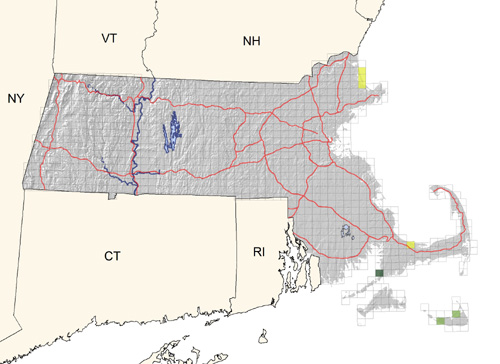Breeding Bird Atlases (BBA)
Find a Bird - BBA1
Breeding Bird Atlas 1 Species Accounts
Clapper Rail
Rallus longirostris
Egg Dates
June 17 to July 3
Number of Broods
one; may re-lay if first attempt fails.

Most literature references cite the Clapper Rail as breeding north to Long Island and Connecticut. The species’ occurrence in Massachusetts increased markedly during the early 1950s and caused observers to suspect nesting here in certain favored salt marshes. The Cape’s first breeding record came from Barnstable in 1956. After this, nests or broods were found also at Nauset and Yarmouthport. This rails’ elusive nature so well preserves the secrets of nesting that Atlas participants were able to make only a single confirmation: at Sippiwisset in Falmouth. Birds calling in May and June were suggestive of breeding at a few other marshes, particularly in the Plum Island region. On Nantucket during 1975 and 1976, birds were present throughout the breeding season at Madaket and Quaise marshes (Andrews). Several other prime areas, particularly on Cape Cod, produced only a surveyor’s hunch that rails should be there.
Once incredibly abundant in the south Atlantic coastal marshes, Clapper Rails suffered heavily from gunners and egg collectors around the turn of the century. When relieved by law from such persecution, rails recovered and became plentiful once again. A new threat emerged as salt marshes were filled in and polluted on a wide scale, destroying the birds’ year-round habitat, because even during migration they seldom venture far from tidal wetlands.
A healthy marsh supports a good population of fiddler crabs and the mollusks, worms, small fish, insects, and other animals that together form 79 percent of the Clapper Rail diet. Clapper Rails stalk their prey by day in the cover of rank herbage, readily slipping among the grass stems with their narrow bodies. By night at low tide, they emerge to feed on flats and creek beds, striding over the mud on long toes. Capable but reluctant fliers, they prefer to run quickly and silently along a maze of pathways or take to the water and swim away rather than to fly.
Clapper Rails forsake stealth only when they give voice. Calls are usually represented by clack or kik or jupe sounds repeated in a series, beginning loud and fast and ending lower and slower. They vocalize by day as well as at dusk and on moonlit nights and often respond to any sudden loud sound. The mating calls, accompanied by exposure of the white undertail coverts, are a hoarse grunting bruck or kid-kik-kik from males and a catlike purring from females.
Though little is known of their migration, it seems probable that small numbers of Clapper Rails that have wintered slightly farther south move north to Massachusetts in late April or May. A nest site is usually well within the cover of saltwater grasses. The pair selects the highest and driest spot in its watery territory, where high tide will be only a few inches deep. Miscalculation is disaster, and much nest mortality is caused by excessively high tides. A nest platform of dead plant material is constructed 8 to 12 inches above the mud in clumps of marsh grass. Growing blades often arch over and conceal the nest. A ramp of dry stalks may connect the nest rim to the ground. Nests measure 8 to 14 inches across and are well cupped to receive up to fourteen (usually eight to twelve) eggs, which are buffy with brown blotches. The Barnstable nest contained ten eggs on June 17, and these hatched on July 3.
The 21- to 23-day incubation period is the time of greatest vulnerability. Parents may raise eggs above invading water by repeatedly tucking vegetation beneath them, but this strategy is of little use in a storm tide. Barring such calamity, the newly hatched black young follow their parents away from the nest. They are independent in 35 to 42 days and can fly in 63 to 70 days. High counts of the year (one to three average; eleven maximum) occur when postbreeding wanderers move into large marshes, such as those at Plum Island, Barnstable, and Wellfleet. On a still October evening, a spontaneous chorus proclaims the gathering of rails. Some may linger into early winter and are fairly regularly reported on Christmas Bird Counts. A few possibly remain year-round, but most move farther south along the Atlantic coast.
Map Legend and Data Summary
Atlas 1 data collected from 1975-1979


Note: rare and local in coastal salt marshes
Wallace Bailey



